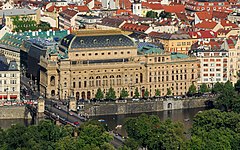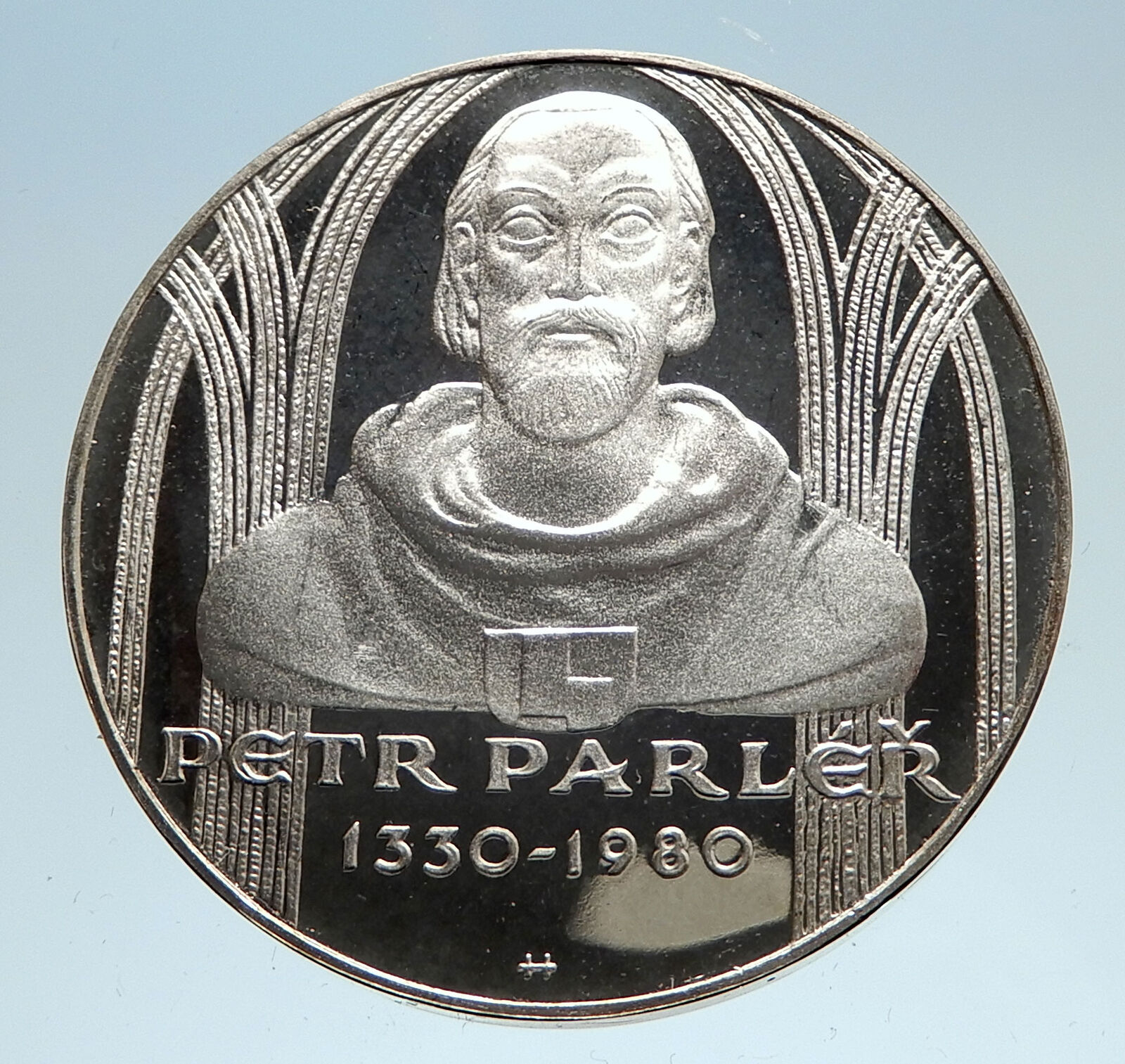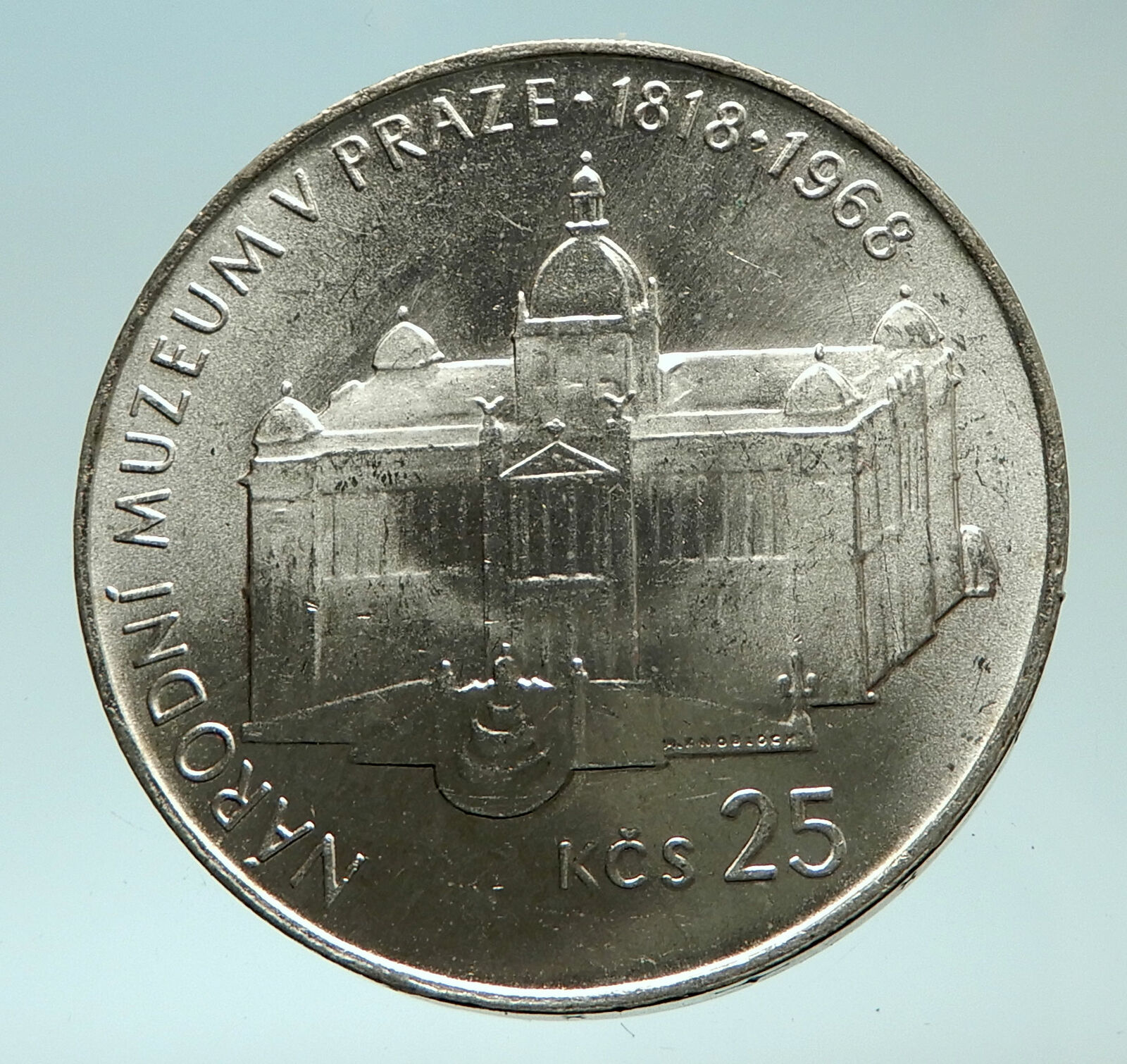|
Czechoslovakia
Centennial – Prague National Theater
1968 Silver 10 Korun 30mm (12.00 grams) 0.500 Silver (0.1929 oz. ASW)
Reference: KM# 63 | Engraver: Jiří Harcuba
ČESKOSLOVENSKÁ SOCIALISTICKÁ REPUBLIKA 10, Czechoslovak coat-of-arms.
NÁRODNÍ DIVADLO V PRAZE 1868 – 1968, Woman holding linden spring on a chariot drawn by three horses.
You are bidding on the exact item pictured, provided with a Certificate of Authenticity and Lifetime Guarantee of Authenticity.
 The National Theatre (Czech: Národní divadlo) in Prague is known as the alma mater of Czech opera, and as the national monument of Czech history and art. The National Theatre (Czech: Národní divadlo) in Prague is known as the alma mater of Czech opera, and as the national monument of Czech history and art.
The National Theatre belongs to the most important Czech cultural institutions, with a rich artistic tradition, which helped to preserve and develop the most important features of the nation–the Czech language and a sense for a Czech musical and dramatic way of thinking.
Today the National Theatre consists of three artistic ensembles: opera, ballet and drama. They alternate in their performances in the historic building of the National Theatre, in the Theatre of the Estates and in the Kolowrat Theatre. All three artistic ensembles select their repertoire both from classical heritage, and modern authors.
The cornerstone of the National Theatre was laid on 16 May 1868, but the idea of building a theatre dates back to the autumn of 1844 at the gatherings of patriots in Prague. An application was submitted by František Palacký to the Provincial Committee of the Bohemian Assembly on 29 January 1845, requesting “the privilege of constructing, furnishing, maintaining and managing” of an independent Czech theatre. The application was granted in April 1845, but it was not until six years later – in April 1851 – that the founding Society for the Establishment of a Czech National Theatre in Prague made the first public appeal to start a collection. A year later the proceeds went toward the purchase of land belonging to a former salt works covering an area of not quite 28 acres (11 ha) which determined the magnificent site of the theatre on the banks of the river Vltava facing the panorama of Prague Castle, but at the same time the cramped area and trapezium shape posed challenging problems for the designers of the building.
The era of von Bach absolutism brought to a halt preparations for the envisaged theatre and supported the concept of a modest provisional building, which was erected on the south side of the theatre parcel by architect Vojtěch Ignác Ullmann and opened on 18 November 1862. The building of the Provisional Theatre then became a constituent part of the final version of the National Theatre; its outside cladding is visible to this day in the elevated section of the rear part of the building, and the interior layout was only obliterated following the latest reconstruction of the National Theatre in 1977 – 1983.
Simultaneously with the realization of this minimal programme asserted by F.L. Rieger and the Provincial Committee, the young progressive advocates of the original ambitious concept of the building (Sladkovský, Tyrš, Neruda, Hálek) launched an offensive. In 1865 these men attained leading positions in the Society and requested the 33-year-old professor of civil engineering at the Prague Technical College, architect Josef Zítek, to draft a design for the National Theatre. He then came out on top in a later-declared open competition, and in 1867 construction work began.
On 16 May 1868, the foundation stone was laid, and in November the foundations were completed. In 1875, the new building reached its full height and in 1877 the theatre was roofed over. As of 1873 there was an ongoing competition for the interior decoration of the building, the scenario of which had been elaborated by a special commission under the leadership of Sladkovský. On the one hand, the themes were in the spirit of the Neo-Renaissance concept of a classic building. On the other hand, they were inspired by the current enthusiasm for Slavonic mythology and the stories of the Manuscripts; both of these concepts were based on Josef Mánes’ paintings and connected with the contemporary style of romantic landscape painting (also linked to Czech history). They provided the fundamental ideology guiding artistic expression, which today is described as the art of the generation of the National Theatre.
The theatre includes a triga (a three-horse chariot) and 10 exterior allegorical sculptures by Bohuslav Schnirch, 10 more exterior pieces by Antonín Pavel Wagner, the stone pieces by Max Verich and an interior sculpted pediment group over the proscenium arch by Schnirch.
Czechoslovakiaia
.svg/75px-Greater_coat_of_arms_of_Czechoslovakia_(1918-1938_and_1945-1961).svg.png) Following Nazi Germany’s surrender, some 2.9 million ethnic Germans were expelled from Czechoslovakia with Allied approval, their property and rights declared void by the Beneš decrees. Following Nazi Germany’s surrender, some 2.9 million ethnic Germans were expelled from Czechoslovakia with Allied approval, their property and rights declared void by the Beneš decrees.
Czechoslovakia soon came to fall within the Soviet sphere of influence..
 The popular enthusiasm evoked by the Soviet armies of liberation (which was decided by compromise of Allies and Joseph Stalin at the Yalta conference in 1944) benefited the KSČ. Czechoslovaks, bitterly disappointed by the West at the Munich Agreement (1938), responded favorably to both the KSČ and the Soviet alliance. Reunited into one state after the war, the Czechs and Slovaks set national elections for the spring of 1946. The popular enthusiasm evoked by the Soviet armies of liberation (which was decided by compromise of Allies and Joseph Stalin at the Yalta conference in 1944) benefited the KSČ. Czechoslovaks, bitterly disappointed by the West at the Munich Agreement (1938), responded favorably to both the KSČ and the Soviet alliance. Reunited into one state after the war, the Czechs and Slovaks set national elections for the spring of 1946.
The democratic elements, led by President Edvard Beneš, hoped the Soviet Union would allow Czechoslovakia the freedom to choose its own form of government and aspired to a Czechoslovakia that would act as a bridge between East and West. Communists secured strong representation in the popularly elected National Committees, the new organs of local administration. In the May 1946 election, the KSČ won most of the popular vote in the Czech part of the bi-ethnic country (40.17%), and the more or less anti-Communist Democratic Party won in Slovakia (62%).
In sum, however, the KSČ only won a plurality of 38 percent of the vote at countrywide level. Edvard Beneš continued as president of the republic, whereas the Communist leader Klement Gottwald became prime minister. Most importantly, although the communists held only a minority of portfolios, they were able to gain control over most of the key ministries (Ministry of the Interior, etc.)
Although the communist-led government initially intended to participate in the Marshall Plan, it was forced by the Kremlin to back out. In 1947, Stalin summoned Gottwald to Moscow; upon his return to Prague, the KSČ demonstrated a significant radicalization of its tactics. On 20 February 1948, the twelve non-communist ministers resigned, in part to induce Beneš to call for early elections; however Beneš refused to accept the cabinet resignations and did not call elections. In the meantime, the KSČ marshalled its forces for the Czechoslovak coup d’état of 1948. The communist-controlled Ministry of the Interior deployed police regiments to sensitive areas and equipped a workers’ militia. On 25 February Beneš, perhaps fearing Soviet intervention, capitulated. He accepted the resignations of the dissident ministers and received a new cabinet list from Gottwald, thus completing the communist takeover under the cover of superficial legality.
On 10 March 1948, the moderate foreign minister of the government, Jan Masaryk, was found dead in suspicious circumstances that have still not been definitively proved to constitute either suicide or political assassination.
In February 1948, the Communists took power in the 1948 Czechoslovak coup d’état, and Edvard Beneš inaugurated a new cabinet led by Klement Gottwald. Czechoslovakia was declared a “people’s democracy” (until 1960) – a preliminary step toward socialism and, ultimately, communism. Bureaucratic centralism under the direction of KSČ leadership was introduced. Dissident elements were purged from all levels of society, including the Roman Catholic Church. The ideological principles of Marxism-Leninism and socialist realism pervaded cultural and intellectual life.
The economy was committed to comprehensive central planning and the abolition of private ownership of capital. Czechoslovakia became a satellite state of the Soviet Union; it was a founding member of the Council for Mutual Economic Assistance (Comecon) in 1949 and of the Warsaw Pact in 1955. The attainment of Soviet-style command socialism became the government’s avowed policy.
Slovak autonomy was constrained; the Communist Party of Slovakia (KSS) was reunited with the KSČ (Communist Party of Czechoslovakia), but retained its own identity. Following the Soviet example, Czechoslovakia began emphasizing the rapid development of heavy industry. Although Czechoslovakia’s industrial growth of 170 percent between 1948 and 1957 was impressive, it was far exceeded by that of Japan (300 percent) and the Federal Republic of Germany (almost 300 percent) and more than equaled by Austria and Greece.
Beneš refused to sign the Communist Constitution of 1948 (the Ninth-of-May Constitution) and resigned from the presidency; he was succeeded by Klement Gottwald. Gottwald died in March 1953. He was succeeded by Antonín Zápotocký as president and by Antonín Novotný as head of the KSČ.
In June 1953, thousands of workers in Plzeň went on strike to demonstrate against a currency reform that was considered a move to solidify Soviet socialism in Czechoslovakia. The demonstrations ended without significant bloodshed, disappointing American Director of Central Intelligence Allen Dulles, who wished for a pretext to help the Czechoslovak people resist the Soviets. For more than a decade thereafter, the Czechoslovak communist political structure was characterized by the orthodoxy of the leadership of party chief Antonín Novotný, who became president in 1957 when Zápotocký died.
In the 1950s, the Stalinists accused their opponents of “conspiracy against the people’s democratic order” and “high treason” in order to oust them from positions of power. In all, the Communist Party tried 14 of its former leaders in November 1952 and sentenced 11 to death. Large-scale arrests of Communists and socialists with an “international” background, i.e., those with a wartime connection with the West, veterans of the Spanish Civil War, Jews, and Slovak “bourgeois nationalists,” were followed by show trials. The outcome of these trials, serving the communist propaganda, was often known in advance and the penalties were extremely heavy, such as in the case of Milada Horáková, who was sentenced to death together with Jan Buchal, Záviš Kalandra and Oldřich Pecl.
The 1960 Constitution declared the victory of socialism and proclaimed the Czechoslovak Socialist Republic (CSSR).
De-Stalinization had a late start in Czechoslovakia. In the early 1960s, the Czechoslovak economy became severely stagnant. The industrial growth rate was the lowest in Eastern Europe. As a result, in 1965, the party approved the New Economic Model, introducing free market elements into the economy. The KSČ “Theses” of December 1965 presented the party response to the call for political reform. Democratic centralism was redefined, placing a stronger emphasis on democracy. The leading role of the KSČ was reaffirmed, but limited. Slovaks pressed for federalization. On 5 January 1968, the KSČ Central Committee elected Alexander Dubček, a Slovak reformer, to replace Novotný as first secretary of the KSČ. On 22 March 1968, Novotný resigned from the presidency and was succeeded by General Ludvík Svoboda.
|





 The National Theatre (Czech: Národní divadlo) in Prague is known as the alma mater of Czech opera, and as the national monument of Czech history and art.
The National Theatre (Czech: Národní divadlo) in Prague is known as the alma mater of Czech opera, and as the national monument of Czech history and art..svg/75px-Greater_coat_of_arms_of_Czechoslovakia_(1918-1938_and_1945-1961).svg.png) Following Nazi Germany’s surrender, some 2.9 million ethnic Germans were expelled from Czechoslovakia with Allied approval, their property and rights declared void by the Beneš decrees.
Following Nazi Germany’s surrender, some 2.9 million ethnic Germans were expelled from Czechoslovakia with Allied approval, their property and rights declared void by the Beneš decrees.  The popular enthusiasm evoked by the Soviet armies of liberation (which was decided by compromise of Allies and Joseph Stalin at the Yalta conference in 1944) benefited the KSČ. Czechoslovaks, bitterly disappointed by the West at the Munich Agreement (1938), responded favorably to both the KSČ and the Soviet alliance. Reunited into one state after the war, the Czechs and Slovaks set national elections for the spring of 1946.
The popular enthusiasm evoked by the Soviet armies of liberation (which was decided by compromise of Allies and Joseph Stalin at the Yalta conference in 1944) benefited the KSČ. Czechoslovaks, bitterly disappointed by the West at the Munich Agreement (1938), responded favorably to both the KSČ and the Soviet alliance. Reunited into one state after the war, the Czechs and Slovaks set national elections for the spring of 1946. 




